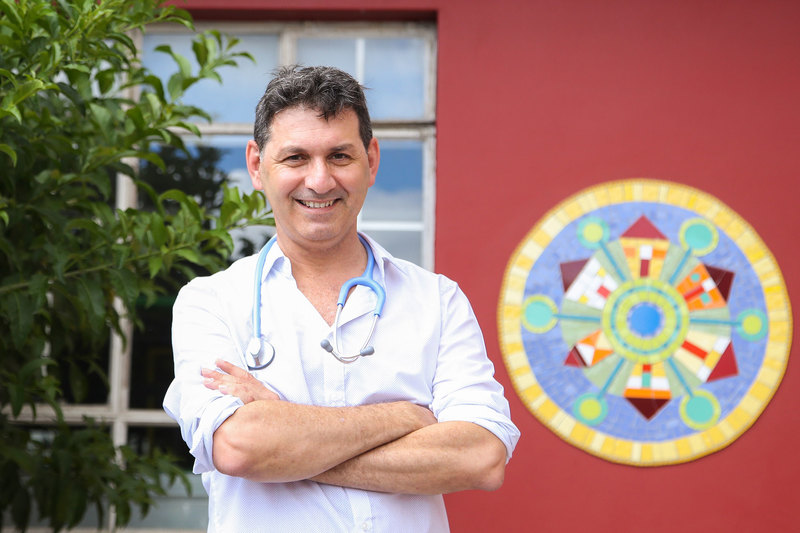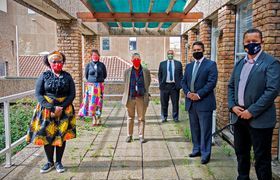First cystic fibrosis registry report for South Africa launched
10 December 2020 | Story Helen Swingler. Photo Je’nine May. Read time 7 min.
University of Cape Town (UCT) paediatric pulmonologist Associate Professor Marco Zampoli and his partners have launched the first report of the South African Cystic Fibrosis Registry. The report will be published annually and will track people living with this rare but debilitating genetic condition.
Cystic fibrosis is a complex multi-organ disease that affects patients and their bodies in many ways, said Zampoli, who is based in the Division of Paediatric Pulmonology at the Red Cross War Memorial Children’s Hospital. There he is the clinical head of the country’s largest paediatric cystic fibrosis clinic – this tracks 100 children under the age of 18.
The main manifestation of cystic fibrosis is the progressive destruction of the lungs, starting at birth, through recurrent chest infections caused by abnormal mucus production, he said. Another organ commonly affected from birth is the pancreas, which secretes digestive enzymes. Children born with cystic fibrosis are unable to digest their food, leading to severe malnutrition if not treated.
“We can also identify areas of cystic fibrosis care that may be deficient in South Africa, which can lead to interventions that address these.”
With clinicians and researchers needing more data, the South African Cystic Fibrosis Registry was established in 2018 in partnership with the South African Cystic Fibrosis Association, a community non-profit organisation. The registry is a database that captures detailed medical information of those diagnosed with the disease. This helps clinicians to identity disease patterns that may be unique to South Africa and monitor the health outcomes in response to new treatments.
“We can also identify areas of cystic fibrosis care that may be deficient in South Africa, which can lead to interventions that address these. As such, it’s an important source of data for future clinical research and patient advocacy.”
First comprehensive data
The newly launched report documents the first comprehensive data of those affected by the disease and will be a valuable tool to monitor progress and advocate for improved care where needed, said Zampoli.
He has been intimately involved in the field for nearly two decades. It is the topic of his current PhD research, and he specialised in paediatric pulmonology after recognising a gap in special care for children with serious lung diseases.
Therapies include lifelong enzyme replacement and regular medications in the form of frequent antibiotics, nebuliser treatment and chest physiotherapy to try and protect the lungs from infections and progressive damage.
“Unfortunately, none of these are curative, and the steady, slow decline in health is inevitable.”
“How well or sick children with cystic fibrosis are depends partly on how early or late they are diagnosed.”
While most wealthy countries have active screening programmes that test all newborn babies for several serious genetic diseases, including cystic fibrosis, South Africa does not.
“How well or sick children with cystic fibrosis are depends partly on how early or late they are diagnosed,” Zampoli explained. “Generally, the sooner cystic fibrosis is diagnosed, the better the long-term prognosis.”
South African figures
As things stand, the disease affects some 520 adults and children in South Africa. How do South Africa’s figures of people with cystic fibrosis compare to that of other countries, both developed and emerging?
“We are currently collaborating with Canadian researchers to answer this question. My impression is we are worse off, but we will compare our data shortly to be more specific.”
Though there is no cure, the overall survival and prognosis of the disease has improved over the past decades thanks to international registry data.
The average survival age of someone born with cystic fibrosis in North America or Europe has doubled in the past 30 years: from 25 to 50 years. An analysis in 2006 by Zampoli’s colleague Associate Professor Tony Westwood of the hospital’s clinic cohort found a median survival age of only 20 years. But there’s little current data on survival age in South Africa, one of the gaps the registry will plug.
“The previous misconception held by many that cystic fibrosis did not occur in indigenous Africans is simply not true.”
“We don’t know exactly how many people are actually living with cystic fibrosis (diagnosed or undiagnosed) in South Africa, but it is likely there are more people we are not aware of who are not receiving care in one of the recognised treatment centres across the country.”
Zampoli encouraged health professionals and the cystic fibrosis community to ensure that they’re listed in the registry and to engage with their doctors and clinics and update details of their visits.
Given the small number of people affected in South Africa, is this an under-researched area?
On the contrary, said Zampoli, it’s one of the most researched genetic diseases in the world, but very little research has been done in South Africa and Africa, until now.
South Africa is the only country in sub-Saharan Africa where cystic fibrosis can be diagnosed or treated.
There are also misconceptions about the disease and how it affects Africans, he added.
“The previous misconception held by many that cystic fibrosis did not occur in indigenous Africans is simply not true. It is very likely that most children born with the disease in Africa are dying very young, undiagnosed or misdiagnosed with other illnesses such as TB or malnutrition.”
Genetic medicine
There is some hope. There has been a breakthrough in the past few years with the development of the first disease-modifying drugs.
“These ‘miracle drugs’ work by partly correcting the CFTR [cystic fibrosis transmembrane conductance regulator] protein produced by inherited faulty cystic fibrosis genes, which then restores some normal function of the protein at cellular levels and reduces symptoms of the disease.”
But the drugs carry a price tag of US$350 000 per patient per year, which is around R5.3 million (“This is lifelong therapy!”). Pharmaceutical company Vertex holds the international patent for these life-saving drugs.
“The politics and ethics around access to these life-saving drugs in the cystic fibrosis world is widely debated,” said Zampoli. “Interest groups worldwide are lobbying Vertex to make them more affordable.”
Zampoli and other cystic fibrosis experts in South Africa have reached out to Vertex to begin discussions about affordable access for poorer countries.
“But it will be a long road, especially as it’s unlikely we will get government support given the rarity of disease and exorbitant costs demanded by Vertex. South African cystic fibrosis patients are being excluded, and this was one of the motivations for establishing the registry: so that we can put cystic fibrosis in South Africa on the world map.”
 This work is licensed under a Creative Commons Attribution-NoDerivatives 4.0 International License.
This work is licensed under a Creative Commons Attribution-NoDerivatives 4.0 International License.
Please view the republishing articles page for more information.










